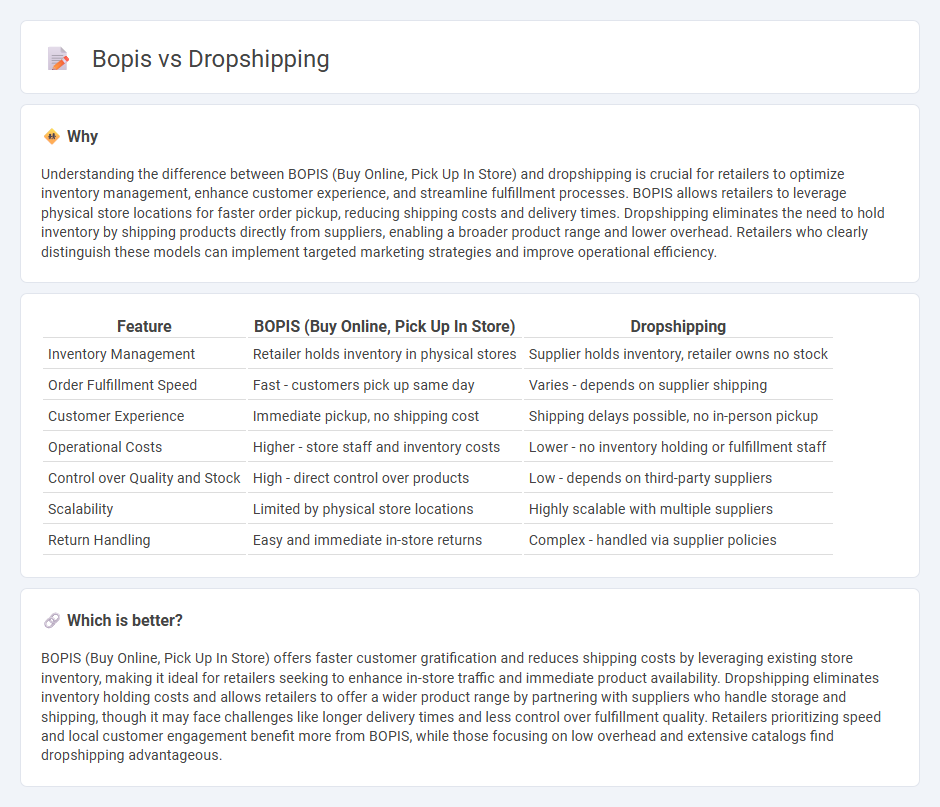
BOPIS (Buy Online, Pick Up In Store) integrates online shopping with physical store pickup, enhancing customer convenience and reducing delivery times. Dropshipping allows retailers to sell products without holding inventory, as suppliers directly ship items to customers, minimizing operational costs. Explore the key differences and advantages of BOPIS and dropshipping to optimize your retail strategy.
Why it is important
Understanding the difference between BOPIS (Buy Online, Pick Up In Store) and dropshipping is crucial for retailers to optimize inventory management, enhance customer experience, and streamline fulfillment processes. BOPIS allows retailers to leverage physical store locations for faster order pickup, reducing shipping costs and delivery times. Dropshipping eliminates the need to hold inventory by shipping products directly from suppliers, enabling a broader product range and lower overhead. Retailers who clearly distinguish these models can implement targeted marketing strategies and improve operational efficiency.
Comparison Table
| Feature | BOPIS (Buy Online, Pick Up In Store) | Dropshipping |
|---|---|---|
| Inventory Management | Retailer holds inventory in physical stores | Supplier holds inventory, retailer owns no stock |
| Order Fulfillment Speed | Fast - customers pick up same day | Varies - depends on supplier shipping |
| Customer Experience | Immediate pickup, no shipping cost | Shipping delays possible, no in-person pickup |
| Operational Costs | Higher - store staff and inventory costs | Lower - no inventory holding or fulfillment staff |
| Control over Quality and Stock | High - direct control over products | Low - depends on third-party suppliers |
| Scalability | Limited by physical store locations | Highly scalable with multiple suppliers |
| Return Handling | Easy and immediate in-store returns | Complex - handled via supplier policies |
Which is better?
BOPIS (Buy Online, Pick Up In Store) offers faster customer gratification and reduces shipping costs by leveraging existing store inventory, making it ideal for retailers seeking to enhance in-store traffic and immediate product availability. Dropshipping eliminates inventory holding costs and allows retailers to offer a wider product range by partnering with suppliers who handle storage and shipping, though it may face challenges like longer delivery times and less control over fulfillment quality. Retailers prioritizing speed and local customer engagement benefit more from BOPIS, while those focusing on low overhead and extensive catalogs find dropshipping advantageous.
Connection
BOPIS (Buy Online, Pick Up In-Store) and dropshipping both streamline retail fulfillment by minimizing inventory holding costs and accelerating delivery times. BOPIS leverages physical stores as local distribution points, reducing shipping distances, while dropshipping fulfills orders directly from third-party suppliers, eliminating the need for retailer warehousing. Combining BOPIS with dropshipping enhances omnichannel strategies, improving customer experience through faster, more flexible order fulfillment options.
Key Terms
Inventory Management
Dropshipping eliminates the need for inventory management by directly shipping products from suppliers to customers, reducing overhead costs and storage challenges. BOPIS (Buy Online, Pick Up In Store) requires careful inventory synchronization between online platforms and physical stores to ensure product availability and avoid stockouts. Explore in-depth strategies to optimize inventory management for both dropshipping and BOPIS models.
Fulfillment Method
Dropshipping fulfillment involves a retailer selling products without holding inventory, where suppliers ship products directly to customers, reducing storage costs and inventory risks. BOPIS (Buy Online, Pick Up In Store) requires maintaining inventory at physical locations, offering customers immediate product access and reduced shipping times. Explore more on how these fulfillment methods impact operational efficiency and customer satisfaction.
Customer Experience
Dropshipping allows customers to access a wide range of products without inventory constraints, often leading to longer shipping times and varied packaging that can impact satisfaction. BOPIS (Buy Online, Pick Up In-Store) enhances customer experience by providing immediate product availability, faster fulfillment, and the convenience of touching and returning items in-store. Explore the benefits and trade-offs of dropshipping and BOPIS to determine which model best elevates your customer experience strategy.
Source and External Links
What Is Dropshipping and How Does It Work? - Dropshipping is a retail fulfillment model where the merchant sells products without keeping inventory, purchasing items from a third-party supplier who ships directly to customers, with the retailer focusing on marketing and customer service.
What Is Dropshipping and How Does It Work? (2025) - Dropshipping involves partnering with suppliers who store, package, and ship products directly to customers, while the retailer manages the online store and sales process, often using apps to automate order forwarding and inventory updates.
Drop shipping - Drop shipping is a form of retail business where sellers accept orders without stock, transferring orders to manufacturers or wholesalers who ship directly, reducing overhead costs but also limiting control over product quality and delivery.
 dowidth.com
dowidth.com